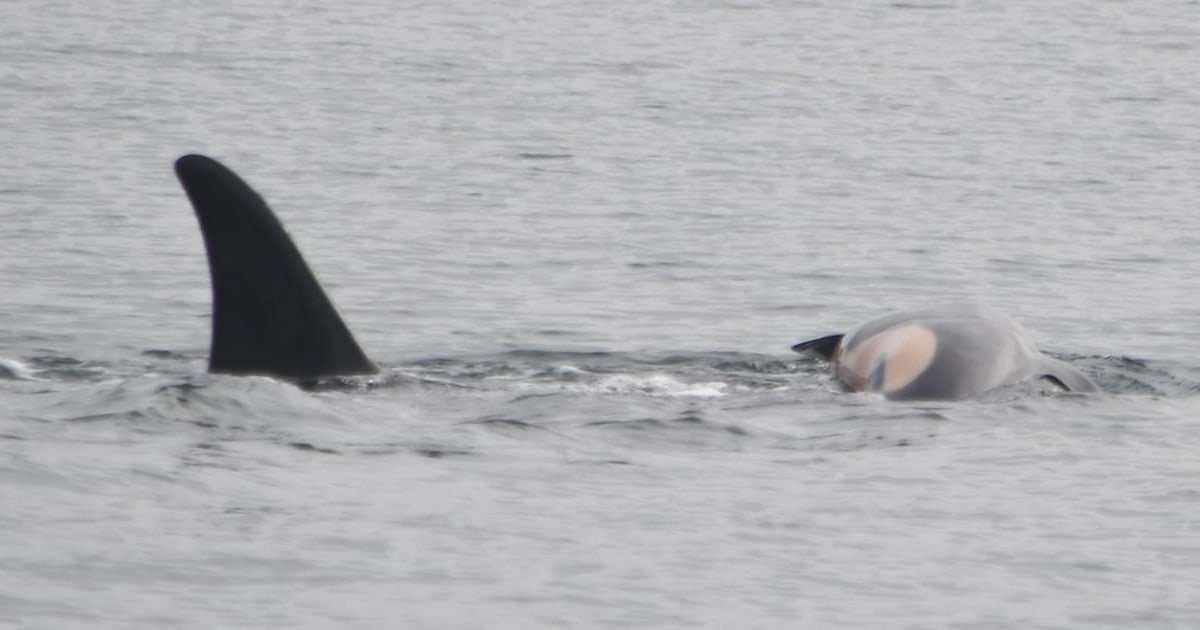The summary
- An orca who carried her dead calf with her for days in 2018 appears to be repeating the behavior with a recently deceased whale calf.
- Scientists believe the orca is likely expressing pain.
- The orca is part of a critically endangered subpopulation known as southern resident killer whales.
Nearly six years ago, a mother orca drew international attention when she carried her dead calf for 17 consecutive days. Now, sadly, the whale appears to be repeating what researchers say is a show of grief for another newborn who has died.
The mother whale, known as J35 and also Tahlequah, was first seen with a new calf on December 20. But on Wednesday, researchers from the National Oceanic and Atmospheric Administration photographed her off West Seattle with the baby whale carcass on her head.
“We were able to confirm that J31 had lost the calf and was pushing her on her head,” Brad Hanson, a research scientist at NOAA’s Northwest Fisheries Science Center, said at a news conference Thursday.
He added that when the calf seems to sag, “it looks like she’s going to do a high arch jump to come down and retrieve the calf, and whether or not she’s pushing it at that point or grabbing it, we’re not quite sure. .”
Scientists said they believe Tahlequah most likely held the deceased calf as an expression of grief. Joe Gaydos, scientific director of the SeaDoc Society, a marine research organization, said at the news conference that whales have similar wiring to humans and other large, long-living social mammals.
“We have the same neurotransmitters as them. We have the same hormones as them. Why shouldn’t we also have the same emotions as them? We do not have the market cornered on emotions. So I think it’s fair to say she’s grieving or mourning,” Gaydos said, adding that similar behavior has been observed in dolphins and non-human primates.
J35 is part of a critically endangered subpopulation of whales known as southern resident killer whales. With the death of the Tahlequah calf and the recent birth of a different orca, the group’s number is only 73.
Over the years, Tahlequah has had two surviving offspring, both males, one of them born in 2020.
Southern residents receive tracking numbers from the Center for Whale Research and are closely watched by researchers, photographers and whale watchers, particularly when near communities along Puget Sound, such as Seattle.
Scientists have been following the story of the deceased calf for several weeks. Hanson said that after citizen scientists first noticed the female calf, named J61, NOAA researchers spotted it themselves on Dec. 23. They were concerned about the calf’s health at the time, he said, because it appeared to be struggling and surfacing abnormally.
It is not uncommon for orca calves to die shortly after birth. Michael Weiss, research director at the Whale Research Center, said the first year of life is the biggest obstacle to survival.
About 70% to 80% of the calves that researchers can document and give identification numbers survive their first years.
“We don’t know exactly what the survival rate is, because many calves are probably born and die before being photographed and documented,” Weiss said. “It’s probably closer to 50% of the calves being born that survive the first year.”
NOAA researchers said they are now concerned about Tahlequah’s health, because pushing the calf creates a lot of resistance in the water and requires a lot of energy.
“One of the things you probably don’t have time to do is forage,” Hanson said. “It’s worrying that he’s spending a lot of energy trying to care for this calf he’s lost.”
This is the typical calving season for southern resident whales. Hanson said researchers were encouraged by the birth of the other orca, named J62, which was first sighted by observers on Dec. 30 and confirmed by the Whale Research Center on New Year’s Day.
“It would appear to be very solid,” Hanson said.
Southern resident killer whales have been the subject of conservation efforts for decades. They are protected by the Marine Mammal Protection Act and were listed as critically endangered in 2005.
Whales typically spend several months a year along the Washington coast in Puget Sound. They live in three groups, called J, K, and L, and have evolved to eat primarily fish, including the prized Chinook salmon.
Beginning in the 1960s, many southern resident killer whales were killed or captured, and some survivors were exhibited in marine parks. In 1974, surveys found that only 71 remained in the wild. The population fluctuated after that: it peaked at 95 in 1995, but has been declining since.
The whales are struggling primarily because the quality and quantity of their prey has decreased and due to contamination from industrial chemicals such as polychlorinated biphenyls (PCBs), which contaminate their prey and accumulate in their bodies. Additionally, noisy boats can disturb the whales and make communication difficult.
Research suggests that southern residents are on a path to extinction unless more aggressive measures are taken. Federal and Washington state agencies have already invested more than $1 billion in programs to reduce threats to whales. But the bottom line remains: southern residents simply do not have enough food.
Key streams that once produced abundant salmon, including the lower Snake River, are dammed, restricting fish access and survival.
“We’re not doing enough on Chinook and salmon recovery,” Gaydos said.
For southern residents, the loss of a calf is a devastating blow not only to its mother but to the trajectory of the entire subspecies.
“The real limitation is the number of females of reproductive age and their ability to successfully raise offspring. So we definitely want to see more women in the population,” Weiss said.







